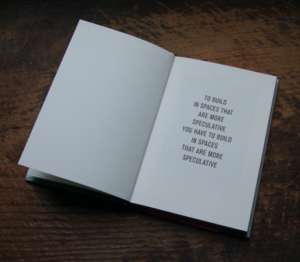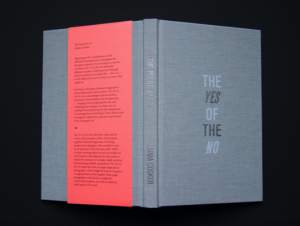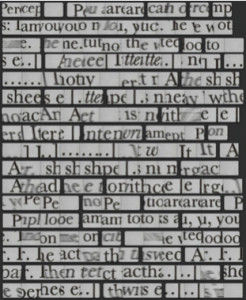Whilst embracing the potential of the essayistic (as a tentative effort or trial), Emma Cocker explores experimental, performative and collaborative approaches to producing texts parallel to and as art practice: the shifts of attention between writing on the page to performance in space and time, between still and moving image, between individual and collective acts of writing. Recent work includes a model of art-writing comprised of dense prose-poetry paragraphs; a fragmentary poetics produced through ‘close reading’ practised as visual magnification; ‘conversation as material’, a collaborative approach using distilled transcription for producing an immanent, intrapersonal mode of writing without writing; alongside collaborative research addressing the knowing-thinking-feeling emerging through the slippage and deviation between expanded writing, drawing and choreographic practices.
On Being Left Open
from Emma Cocker, The Yes of the No (Sheffield: Site Gallery, 2016)
To leave something open is to declare it unfinished or incomplete; a work in progress, still unresolved. Being open can signal towards a neutral state or the capacity for polyvalence, for manifold meaning. It is (a) not shut or closed; (b) having no protecting or concealing cover; (c) carried on in full view; (d) not closely defended by an opponent; (e) not sealed or tied; (f) having interspersed gaps, spaces, or intervals; (g) accessible; (h) free from limitations, boundaries or restrictions; (i) to speak freely and candidly; (j) to open (one’s) eyes, to become aware of the truth of a situation; (k) willing to consider or deal with something; (l) ready to transact business; (m) not yet decided, subject to further thought; (n) characterised by lack of pretense or reserve, free; (o) free of prejudice, receptive to new ideas and understanding; (p) generous; (q) in operation, live; (r) to undo, to release from a closed or fastened position; (s) to remove obstructions from, clear; (t) to get (something) going, initiate; (u) to make or force an opening or gap in, to break the continuity of; (v) to make more responsive or understanding; (w) to reveal the secrets of, to bare; (x) to modify (one’s stance); (y) to accelerate; (z) susceptible, vulnerable. Open space is that which has yet to be territorialised, brought under private own. However, with openness comes vulnerability, for a space can soon become unruly in the absence of any rule. To leave something open thus carries an attendant risk, for it is an unprotected state whose facing edges remain exposed. An island is the land mass most marginal; its identity shaped by the exposure of its open shoreline and its perception of risk therein. Danger might be averted by protecting the raw edge; treating it as an open wound or sore. However, the covered wound is often prone to fester; better then to trust it to the good of the air. Resistance is the tolerance garnered through an encounter with minor risk and danger; not the fear fostered in the attempt to maintain one’s distance, keep peril at bay. Openness thus cultivates resilience with receptivity. It is an operation of affirmation rather than of defense.
The Yes of the No


Sheffield: Site Gallery, 2016
Emma Cocker, Close Reading, 2016

